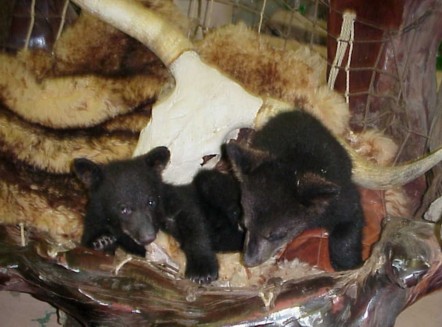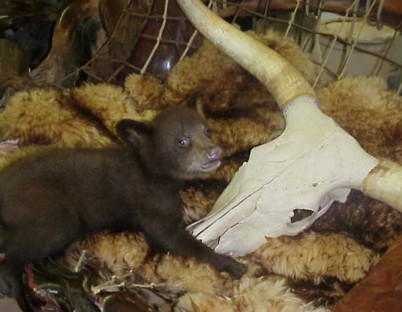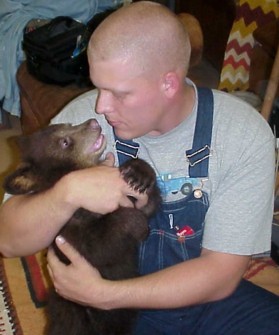Bears
2 very lucky male baby bears. Hand-raised and people friendly.
Sonia's on left, Jean-Phillipe's on right.
I look down at the 'almost' angelic face of
the baby bear cradled in my arms, much like a human baby. I marvel at the expressive
face, eyes closed, sucking frantically at the bottle. How lucky I am, to do this
for a living!!! At R-Zu-2-U, we do not maintain an adult population of bears,
but we do hand-raise cubs on special order for customers that have the necessary
experience with these amazing mammals. We only place bear cubs with organizations
that have a habitat that is asthetically pleasing, healthy and interesting to
the bears.
I can't begin to tell you the incredible and very personal feelings I get when
I raise a baby animal from birth. To feed, weigh, nurture and monitor its health
and well-being and see it turn out into a well-adjusted animal in captivity.
Bears are another of nature's marvels. They are very efficient users of the food
that they consume, having a minimum of excrement for the volume of food that they
eat. In the winter when they enter their dens for a long sleep, they draw upon
the fat reserves they have built up in the fall when they ate enormous amounts
of food. During the winter, they do not eat or drink and that is the time the
mother gives birth to her young.
Baby bears are very small when they are born, compared to the size they will be
at maturity. The American Black bear (which can be black, brown, cinnamon or cream/white)
weighs just 6 to 8 ounces at birth. There can be from one to four in a litter.
It spends the next months nursing its mother in the den, and growing so it will
be capable of following her when she emerges from the den in spring.
A mother bear's milk is very rich, and as thick as the thickest whipping cream
you have ever seen. The formula we feed baby bears is very thick and it must go
through a cross cut nipple which we have to enlarge as the bear gets older and
more anxious for its meal to flow faster. Baby bears are very passionate about
their bottles and very possessive. If you have more than one cub, its wise to
have two people to feed them or they must be fed separately and out of site of
the other cub(s) or it will cry like a human baby - only louder - if it thinks
it is missing out. Baby bears start out laying on their stomachs to nurse and
as they grow up, a hand-raised bear really becomes 'hand' raised, because it will
stand up on its hind legs and wrap its arms and paws around your forearm. Because
of the treacherous claws, it is more than prudent to wear a welder's glove. I
have long permanent purple scars on my right arm because I was taking a shortcut
at one feeding and eliminated the glove. I thought my arm was being fileted like
a fish. The bear was not being aggressive, just possessive. When older, they will
not believe the bottle is empty and can grab it and run around with it dangling
from their teeth for a while.
Bears do not take to weaning well, because they do not want to give up their bottle.
They may not wean until 4 to 6 months but when they do, their life's ambition
is to spend 23 hours a day eating - anything in sight.
Bears are true omnivores, which means they will eat both vegetable matter and
meat. When you are trying to wean a baby bear to solid food it will give you hard
time when it comes to that food, but will eat its toys, paper, wood, your chair,
your shoes, your socks and your dog's tail.
Teenage and adult bears are not to be taken lightly. Their lives are ruled by
food and sex and food and sex. What a life! I used to know a guy like that! Other
than that, I don't think they think about anything except defending themselves,
their den and offspring or their feeding territory.
There are 4 genera and 7 species of bears today. Along with greater and lesser
pandas they are classified in the Order: Carnivora, Family: Ursidae
Today's taxonomic classification of the bear family is:
Ursidae (Bears and Pandas)
Ailurinae (Pandas)
Ailuropoda
Ailuropoda melanoleuca (Greater Panda)
Ailurus
Ailurus fulgens (Lesser Panda)
Ursinae (Bears)
Helarctos
Helarctos malayanus (Malayan Sun Bear)
Melursus
Melursus ursinus (Sloth Bear)
Tremarctos
Tremarctos ornatus (Specticled Bear)
Ursus
Ursus americanus (American Black Bear)
Ursus arctos (Brown Bear or Grizzly Bear)
Ursus maritimus (Polar Bear)
Ursus thibetanus (Asiatic Black Bear)
The bears with which we are most familiar are the American Black Bears.
They like other bears are heavily built with a very stock body and short, strong
legs armed with five formidable claws on each foot. Bears have small eyes, rounded
ears, strong jaws, and short tails. They walk planitgrade which means that the
heels and soles of their feet both touch the ground when they walk (Like humans).
Bears use can deftly their paws to tenderly hold their young and rip open logs
for insects and honey.
Two cinnamon females - Sonia's on bottom, Jean-Phillipe's
on top.
Although bears appear to move slowly, they
are capable of great bursts of speed to catch prey or chase a rival or enemy.
Bears are very powerful and need enclosures that are strong and 'bomb' proof.
They need a cozy winter den for hibernation. They must be treated fairly and with
great respect. These animals do not eat or drink once they enter the den for the
winter and their body temperature drops from about 101 degrees F to as low as
85 degrees F.
Depending on the location, some bears hibernate as long as 8 months.
The American black bear is endangered in Mississippi, Texas and Louisiana.
Bears
R-Zu-2-U Home
R-Zu-2-U FAQs
R-Zu-2-U Animal "Terms"
Treasure Ranch Home



